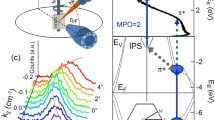Abstract
The π + σ plasmons in a strongly oriented pyrolitic graphite were studied experimentally using the characteristic electron energy loss technique with an angular resolution in the reflection mode. It was established that the bulk intralayer π + σ plasma bands have two branches with a positive and a negative dispersion, respectively. Each dispersion branch of the π + σ plasmons is a doublet. The interlayer plasmons are characterized by a positive dispersion coefficient only. The results are interpreted qualitatively based on the special features of the electronic band spectrum of graphite. The doublet arises because both dipole and multipole interband transitions similar in intensity are excited in graphite exposed to electron bombardment.
Similar content being viewed by others
References
M. S. Dresselhaus, G. Dresselhaus, and P. Avouris, Topics in Applied Physics, Vol. 80: Carbon Nanotubes: Synthesis, Structure, Properties, and Applications (Springer-Verlag, Berlin, 2001), p. 447.
B. Vasvari, Phys. Rev. B: Condens. Matter 55(12), 7993 (1997).
S. Logothetidis, Diamond Relat. Mater. 12, 141 (2003).
H. Raether, Excitation of Plasmons and Interband Transitions by Electrons (Springer-Verlag, Berlin, 1980), p. 192.
C. Yannouleas, E. Bogachek, and U. Landman, Phys. Rev. B: Condens. Matter 53(10), 225 (1996).
S. Prawer, K. W. Nugent, D. N. Jamieson, and J. O. Orwa, Chem. Phys. Lett. 332, 93 (2000).
E. M. Baĭtinger, M. M. Brzhezinskaya, and V. V. Shnitov, Khim. Fiz. Mezoskopiya 4(2), 178 (2002).
V. V. Shnitov, V. M. Mikoushkin, and A. V. Zacharevich, in Proceedings of the 14th European Conference on Surface Science (ECOSS-14), Leipzig, 1994 (Leipzig, 1994), p. 76.
L. Papagno, L. Caputi. Surf. Sci. 125(2), 530 (1983).
L. Vitali, M. A. Schneider, K. Kern, L. Wirtz, and A. Rubio, Phys. Rev. B: Condens. Matter 69(121), 414(R) (2004).
S. Xu, J. Cao, C. C. Miller, D. A. Mantell, R. Miller, and Y. Gao, Phys. Rev. Lett. 76(3), 483 (1996).
U. Kreibig and M. Vollmer, Optical Properties of Metal Clusters (Springer-Verlag, Berlin, 1995).
P. C. Clemmow and J. P. Dougherty, Electrodynamics of Particles and Plasmas (Addison-Wesley, Redwood City, CA, 1990; Mir, Moscow, 1996).
R. Tatar and S. Rabii, Phys. Rev. B: Condens. Matter 25(6), 4126 (1982).
F. Bassani and G. Pastori Parravicini, Electronic States and Optical Transition in Solids (Pergamon, Oxford, 1975; Nauka, Moscow; 1982).
E. M. Baĭtinger, Electronic Structure of Condensed Carbon (Ural State University, Sverdlovsk, 1988) [in Russian].
S. Y. Park and D. Stround, Phys. Rev. B: Condens. Matter 69, 125418 (2004).
Author information
Authors and Affiliations
Additional information
Original Russian Text © E.M. Baĭtinger, 2006, published in Fizika Tverdogo Tela, 2006, Vol. 48, No. 8, pp. 1380–1384.



